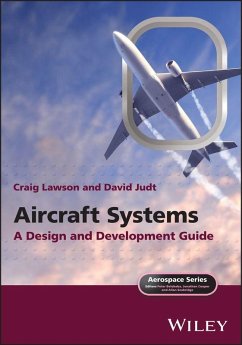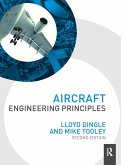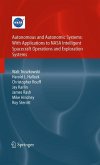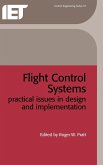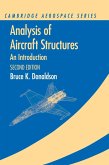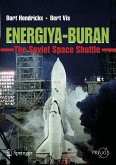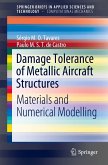- Gebundenes Buch
- Merkliste
- Auf die Merkliste
- Bewerten Bewerten
- Teilen
- Produkt teilen
- Produkterinnerung
- Produkterinnerung
Aircraft Systems: A Design and Development Guide is a textbook whichcomprehensively covers the design and development of electrical and mechanical systems for fixed wing aircraft. It takes a practical approach and includes examples throughout based on commercial and military aircraft. Academic design studies and methods are presented and technical and mathematical methods of design are also included. Aircraft Systems: A Design and Development Guide provides broad coverage of aircraft systems, covering electrical power systems, hydraulics, pneumatics, flight control actuation and landing gear,…mehr
Andere Kunden interessierten sich auch für
![Aircraft Engineering Principles Aircraft Engineering Principles]() Lloyd DingleAircraft Engineering Principles234,99 €
Lloyd DingleAircraft Engineering Principles234,99 €![Autonomous and Autonomic Systems: With Applications to NASA Intelligent Spacecraft Operations and Exploration Systems Autonomous and Autonomic Systems: With Applications to NASA Intelligent Spacecraft Operations and Exploration Systems]() Walt TruszkowskiAutonomous and Autonomic Systems: With Applications to NASA Intelligent Spacecraft Operations and Exploration Systems166,99 €
Walt TruszkowskiAutonomous and Autonomic Systems: With Applications to NASA Intelligent Spacecraft Operations and Exploration Systems166,99 €![Flight Control Systems: Practical Issues in Design and Implementation Flight Control Systems: Practical Issues in Design and Implementation]() Flight Control Systems: Practical Issues in Design and Implementation157,99 €
Flight Control Systems: Practical Issues in Design and Implementation157,99 €![Analysis of Aircraft Structures Analysis of Aircraft Structures]() Bruce K. DonaldsonAnalysis of Aircraft Structures174,99 €
Bruce K. DonaldsonAnalysis of Aircraft Structures174,99 €![Energiya-Buran Energiya-Buran]() Bart HendrickxEnergiya-Buran77,99 €
Bart HendrickxEnergiya-Buran77,99 €![Challenger Challenger]() Adam HigginbothamChallenger15,99 €
Adam HigginbothamChallenger15,99 €![Damage Tolerance of Metallic Aircraft Structures Damage Tolerance of Metallic Aircraft Structures]() Sérgio M. O. TavaresDamage Tolerance of Metallic Aircraft Structures46,99 €
Sérgio M. O. TavaresDamage Tolerance of Metallic Aircraft Structures46,99 €-
-
-
Aircraft Systems: A Design and Development Guide is a textbook whichcomprehensively covers the design and development of electrical and mechanical systems for fixed wing aircraft. It takes a practical approach and includes examples throughout based on commercial and military aircraft. Academic design studies and methods are presented and technical and mathematical methods of design are also included. Aircraft Systems: A Design and Development Guide provides broad coverage of aircraft systems, covering electrical power systems, hydraulics, pneumatics, flight control actuation and landing gear, to name a few. It includes design guides for each system and also covers environmental concerns for aircraft control systems.
Produktdetails
- Produktdetails
- Verlag: Wiley John + Sons
- Seitenzahl: 224
- Erscheinungstermin: 8. Januar 2026
- Englisch
- Abmessung: 244mm x 170mm
- ISBN-13: 9781119113188
- ISBN-10: 1119113180
- Artikelnr.: 60011584
- Herstellerkennzeichnung
- Libri GmbH
- Europaallee 1
- 36244 Bad Hersfeld
- gpsr@libri.de
- Verlag: Wiley John + Sons
- Seitenzahl: 224
- Erscheinungstermin: 8. Januar 2026
- Englisch
- Abmessung: 244mm x 170mm
- ISBN-13: 9781119113188
- ISBN-10: 1119113180
- Artikelnr.: 60011584
- Herstellerkennzeichnung
- Libri GmbH
- Europaallee 1
- 36244 Bad Hersfeld
- gpsr@libri.de
About the Authors x
Series Preface xi
Preface xii
1 Introduction 1
1.1 Which Are the Airframe Systems? 2
1.2 Aircraft Systems Design Processes and Aircraft-Level
Considerations 2
1.3 Systems Integration 2
Bibliography 5
2 Airframe System Design Process 6
2.1 Introduction 6
2.1.1 Systems Design Approach 6
2.1.2 Safety Assessment Philosophy 7
2.1.3 Aircraft Systems Design Methods 8
2.1.4 SAE ARP4754A 8
2.1.5 SAE ARP4761 9
2.2 Requirements Capture 9
2.3 System Safety Assessment 11
2.3.1 Functional Hazard Assessment 11
2.3.2 Development Assurance Process and Levels 13
2.3.3 Fault Tree Analysis 14
2.3.4 Failure Modes and Effects Analysis 15
2.4 System Architectures 16
2.4.1 Representing Architectures 17
2.4.2 Architectures for Analysis 18
2.5 System Design for Maintainability 19
2.5.1 Maintenance Cost Estimation 20
2.5.2 Accessibility 21
2.5.3 System Ageing and Obsolescence 24
2.6 Aircraft Level Trade-off
Analysis 24
2.6.1 Fuel Penalties 25
2.7 Cost 31
2.7.1 Subsystem Cost Breakdown 31
2.7.2 Estimation Approaches 31
2.8 Summary 35
References 35
3 Aircraft Secondary Power Systems 37
3.1 Introduction 37
3.2 Secondary Power Forms 37
3.2.1 Pneumatic Power Systems 37
3.2.2 Hydraulic Power Systems 39
3.2.3 Electrical Power Systems 40
3.2.4 Variable-Frequency
AC 41
3.2.5 Fixed-Frequency
AC 41
3.2.6 High-Voltage
DC 41
3.2.7 Low-Voltage
DC 41
3.3 Secondary Power Sources 42
3.3.1 Aircraft-Level
Effects 42
3.3.2 Advantages and Disadvantages 43
3.3.3 Trade Study 44
3.3.4 Main Engines 45
3.3.5 Auxiliary Power Units 46
3.3.6 Ground Power Units 47
3.3.7 Ram Air Turbines 48
3.3.8 Emergency Power Units 49
3.3.9 Stored Energy and Batteries 49
4 Aircraft Pneumatic Power Systems 51
4.1 Introduction 51
4.2 The Requirements for Aircraft Pneumatic Power Systems 51
4.2.1 Airworthiness Requirements 52
4.3 Bleed Air Systems Design 53
4.4 Bleed Air Systems Components 54
4.4.1 Pneumatic Valves 54
4.4.2 Pre-coolers
54
4.4.3 Ducting 55
4.5 The Use of Bleed Air 56
4.5.1 Engine Starting Systems 56
4.5.2 Engine Thrust Reversing and Variable Nozzle Geometry Systems 57
4.5.3 Pitot-Static
System 57
4.6 Boeing 767 Pneumatic System 57
Bibliography 59
5 Hydraulic Power Systems 60
5.1 Introduction 60
5.2 Hydraulic System Components 61
5.2.1 Hydraulic Fluids 61
5.2.2 Hydraulic Pumps 63
5.2.3 Hydraulic Pumps for Low-Pressure
Applications 64
5.2.4 Hydraulic Pumps for High-Pressure
Applications 65
5.2.5 Hydraulic Piping 68
5.2.6 Reservoirs 70
5.2.7 Filters 72
5.2.8 Accumulators 74
5.2.9 Pressure Control Valves 74
5.2.10 Heat Exchangers 76
5.2.11 Power Control Units 76
5.3 Hydraulic System Aircraft Applications 80
5.3.1 Boeing 737 Hydraulic System 80
5.3.2 BAE Systems Hawk Hydraulic System 80
5.4 Requirements, System Design, Analysis and Sizing 82
5.4.1 Requirements Definition 82
5.4.2 Performance Requirements Analysis 83
5.4.3 Architecture Definitions 86
5.4.4 System Simulation and Control 88
5.5 Summary 88
References 89
6 Aircraft Electrical Power Systems 90
6.1 Introduction 90
6.2 The Requirements for Aircraft Electrical Power Systems 91
6.2.1 Airworthiness Requirements 92
6.3 Electrical Power Generation 92
6.3.1 DC Power Generation 92
6.3.2 AC Power Generation 94
6.4 Electrical Power Conversion 98
6.4.1 AC-to-
DC
Conversion Using TRUs 99
6.4.2 AC-to-
AC
Conversion Autotransformers 99
6.4.3 DC-to-
AC
Conversion Using Inverters 99
6.5 Electrical Power Distribution 100
6.5.1 Busbar Systems 100
6.5.2 Circuit Overload Protection 100
6.5.3 Wires and Cablings 101
6.5.4 Connectors 102
6.5.5 Current Return Earthing and Grounding 102
6.5.6 Electrical Bonding and Static Electricity Discharge 103
6.6 Electrical Power System Architectures 104
6.6.1 Typical 28 VDC System 104
6.6.2 Airbus A320 115 VAC 400 Hz System 105
6.6.3 Boeing 787 235 VAC System 106
6.6.4 F-22
Raptor 270 VDC System 107
References 107
7 Flight Control Actuation Systems 108
7.1 Introduction 108
7.2 Control Surfaces 109
7.3 Flight Control Linkage Systems 111
7.3.1 Push-Pull Control Rod Systems 111
7.3.2 Cable-and-
Pulley
Systems 112
7.4 Trim Systems 112
7.5 Feel Systems 113
7.5.1 Spring Feel 113
7.5.2 'Q' Feel 113
7.6 Actuation Systems Using Hydraulic Actuators 114
7.6.1 Hydraulic Actuation with Mechanical Control 114
7.6.2 Hydraulic Actuation with Electrical Control 114
7.6.3 Types of Hydraulic Actuator 115
7.7 Actuation Systems Using Electro-Hydrostatic
Actuators 116
7.8 Actuation Systems Using Electro-Mechanical
Actuators 117
7.8.1 EMA Components and Operation 118
7.8.2 Types of EMA 118
7.8.3 EMA Advantages and Challenges 119
7.9 Fly-By-
Wire
Systems 120
7.9.1 A320 FBW Actuation System 120
7.9.2 A380 FBW Actuation System 121
7.10 Actuator Design Requirements and Sizing 122
7.11 Basic Actuator Design Considerations and 'Rules of Thumb' for Sizing
123
7.12 Summary 125
Bibliography 126
8 Aircraft Icing, Ice and Rain Protection Systems 127
8.1 Introduction 127
8.2 Aircraft Icing Conditions in Flight 128
8.3 Airworthiness Requirements 130
8.4 Ice Build-up
in Flight 135
8.5 Estimation of Ice Accretion on an Aerofoil Surface in Flight 136
8.6 Aircraft Ice Protection Systems 140
8.6.1 Thermal Ice Protection Systems 140
8.6.2 Mechanical Ice Protection Systems 144
8.6.3 Chemical Ice Protection Systems 146
8.6.4 Hydrophobic and Ice-phobic
Anti-icing
147
8.7 Aircraft Ground Icing 147
8.8 Ground Anti-icing
and De-icing
147
8.9 Rain Protection 148
Bibliography 149
9 Aircraft Environmental Control Systems 150
9.1 Introduction 150
9.2 The Requirements for Aircraft ECS 150
9.2.1 Temperature Drivers 150
9.2.2 Humidity 152
9.2.3 Pressure and Oxygen Drivers 153
9.2.4 Aircraft Equipment Requirements 154
9.2.5 Human Requirements 154
9.2.6 Human Fresh Airflow Requirements 156
9.2.7 Airworthiness Requirements 157
9.3 Cabin Heat Balance Calculations 158
9.3.1 Kinetic Heating 158
9.3.2 Solar Heating 158
9.3.3 Avionics and Airframe Systems Heat Loads 159
9.3.4 Aircraft Occupants Heat Loads 159
9.3.5 Conduction Through the Aircraft Skin 159
9.3.6 Overall Heat Balance Equation 160
9.4 ECS Designs 160
9.4.1 Ram Air Coolant-Based Systems 161
9.4.2 Electrically Powered Air-Cycle
Refrigerators 164
9.4.3 Vapour Cycle Refrigeration 166
9.5 Environmental Control Subsystems 168
9.5.1 Cabin Pressurisation and Control 168
9.5.2 Humidity Control 169
9.5.3 Ozone Conversion 170
9.5.4 Filtration of Re-circulated
Cabin Air 170
9.5.5 ACM Heat Exchangers 171
9.5.6 ACM Compressor and Turbine 172
9.5.7 Air Distribution 173
9.6 Oxygen Systems 173
9.6.1 Liquid Storage of Oxygen 174
9.6.2 Oxygen Concentration of Outside Air 174
9.6.3 High-Pressure
Gaseous Storage of Oxygen 175
9.6.4 Oxygen Generation by Chemical Reaction 176
9.7 Example Complete ECS 176
Bibliography 178
10 Fuel and Fuel Systems 179
10.1 Introduction 179
10.2 Aviation Fuels 179
10.2.1 Fuels for Piston-Engine
Aircraft 179
10.2.2 Fuels for Turbine-Engine
Aircraft 181
10.3 Fuel System Components 182
10.3.1 Fuel Tanks 182
10.3.2 Pumps 185
10.3.3 Valves 189
10.3.4 Level Sensors and Gauging Probes 190
10.4 Engine Feed Systems 192
10.5 Fuel Transfer Systems 193
10.6 Refuel/Defuel Systems 194
10.7 Vent Systems 196
10.8 Fuel Quantity Measurement Systems 197
10.9 Fuel System Contamination 198
10.10 Fuel Jettison 198
10.11 Design Process Considerations 198
10.12 Summary 209
References 209
Index 000
Series Preface xi
Preface xii
1 Introduction 1
1.1 Which Are the Airframe Systems? 2
1.2 Aircraft Systems Design Processes and Aircraft-Level
Considerations 2
1.3 Systems Integration 2
Bibliography 5
2 Airframe System Design Process 6
2.1 Introduction 6
2.1.1 Systems Design Approach 6
2.1.2 Safety Assessment Philosophy 7
2.1.3 Aircraft Systems Design Methods 8
2.1.4 SAE ARP4754A 8
2.1.5 SAE ARP4761 9
2.2 Requirements Capture 9
2.3 System Safety Assessment 11
2.3.1 Functional Hazard Assessment 11
2.3.2 Development Assurance Process and Levels 13
2.3.3 Fault Tree Analysis 14
2.3.4 Failure Modes and Effects Analysis 15
2.4 System Architectures 16
2.4.1 Representing Architectures 17
2.4.2 Architectures for Analysis 18
2.5 System Design for Maintainability 19
2.5.1 Maintenance Cost Estimation 20
2.5.2 Accessibility 21
2.5.3 System Ageing and Obsolescence 24
2.6 Aircraft Level Trade-off
Analysis 24
2.6.1 Fuel Penalties 25
2.7 Cost 31
2.7.1 Subsystem Cost Breakdown 31
2.7.2 Estimation Approaches 31
2.8 Summary 35
References 35
3 Aircraft Secondary Power Systems 37
3.1 Introduction 37
3.2 Secondary Power Forms 37
3.2.1 Pneumatic Power Systems 37
3.2.2 Hydraulic Power Systems 39
3.2.3 Electrical Power Systems 40
3.2.4 Variable-Frequency
AC 41
3.2.5 Fixed-Frequency
AC 41
3.2.6 High-Voltage
DC 41
3.2.7 Low-Voltage
DC 41
3.3 Secondary Power Sources 42
3.3.1 Aircraft-Level
Effects 42
3.3.2 Advantages and Disadvantages 43
3.3.3 Trade Study 44
3.3.4 Main Engines 45
3.3.5 Auxiliary Power Units 46
3.3.6 Ground Power Units 47
3.3.7 Ram Air Turbines 48
3.3.8 Emergency Power Units 49
3.3.9 Stored Energy and Batteries 49
4 Aircraft Pneumatic Power Systems 51
4.1 Introduction 51
4.2 The Requirements for Aircraft Pneumatic Power Systems 51
4.2.1 Airworthiness Requirements 52
4.3 Bleed Air Systems Design 53
4.4 Bleed Air Systems Components 54
4.4.1 Pneumatic Valves 54
4.4.2 Pre-coolers
54
4.4.3 Ducting 55
4.5 The Use of Bleed Air 56
4.5.1 Engine Starting Systems 56
4.5.2 Engine Thrust Reversing and Variable Nozzle Geometry Systems 57
4.5.3 Pitot-Static
System 57
4.6 Boeing 767 Pneumatic System 57
Bibliography 59
5 Hydraulic Power Systems 60
5.1 Introduction 60
5.2 Hydraulic System Components 61
5.2.1 Hydraulic Fluids 61
5.2.2 Hydraulic Pumps 63
5.2.3 Hydraulic Pumps for Low-Pressure
Applications 64
5.2.4 Hydraulic Pumps for High-Pressure
Applications 65
5.2.5 Hydraulic Piping 68
5.2.6 Reservoirs 70
5.2.7 Filters 72
5.2.8 Accumulators 74
5.2.9 Pressure Control Valves 74
5.2.10 Heat Exchangers 76
5.2.11 Power Control Units 76
5.3 Hydraulic System Aircraft Applications 80
5.3.1 Boeing 737 Hydraulic System 80
5.3.2 BAE Systems Hawk Hydraulic System 80
5.4 Requirements, System Design, Analysis and Sizing 82
5.4.1 Requirements Definition 82
5.4.2 Performance Requirements Analysis 83
5.4.3 Architecture Definitions 86
5.4.4 System Simulation and Control 88
5.5 Summary 88
References 89
6 Aircraft Electrical Power Systems 90
6.1 Introduction 90
6.2 The Requirements for Aircraft Electrical Power Systems 91
6.2.1 Airworthiness Requirements 92
6.3 Electrical Power Generation 92
6.3.1 DC Power Generation 92
6.3.2 AC Power Generation 94
6.4 Electrical Power Conversion 98
6.4.1 AC-to-
DC
Conversion Using TRUs 99
6.4.2 AC-to-
AC
Conversion Autotransformers 99
6.4.3 DC-to-
AC
Conversion Using Inverters 99
6.5 Electrical Power Distribution 100
6.5.1 Busbar Systems 100
6.5.2 Circuit Overload Protection 100
6.5.3 Wires and Cablings 101
6.5.4 Connectors 102
6.5.5 Current Return Earthing and Grounding 102
6.5.6 Electrical Bonding and Static Electricity Discharge 103
6.6 Electrical Power System Architectures 104
6.6.1 Typical 28 VDC System 104
6.6.2 Airbus A320 115 VAC 400 Hz System 105
6.6.3 Boeing 787 235 VAC System 106
6.6.4 F-22
Raptor 270 VDC System 107
References 107
7 Flight Control Actuation Systems 108
7.1 Introduction 108
7.2 Control Surfaces 109
7.3 Flight Control Linkage Systems 111
7.3.1 Push-Pull Control Rod Systems 111
7.3.2 Cable-and-
Pulley
Systems 112
7.4 Trim Systems 112
7.5 Feel Systems 113
7.5.1 Spring Feel 113
7.5.2 'Q' Feel 113
7.6 Actuation Systems Using Hydraulic Actuators 114
7.6.1 Hydraulic Actuation with Mechanical Control 114
7.6.2 Hydraulic Actuation with Electrical Control 114
7.6.3 Types of Hydraulic Actuator 115
7.7 Actuation Systems Using Electro-Hydrostatic
Actuators 116
7.8 Actuation Systems Using Electro-Mechanical
Actuators 117
7.8.1 EMA Components and Operation 118
7.8.2 Types of EMA 118
7.8.3 EMA Advantages and Challenges 119
7.9 Fly-By-
Wire
Systems 120
7.9.1 A320 FBW Actuation System 120
7.9.2 A380 FBW Actuation System 121
7.10 Actuator Design Requirements and Sizing 122
7.11 Basic Actuator Design Considerations and 'Rules of Thumb' for Sizing
123
7.12 Summary 125
Bibliography 126
8 Aircraft Icing, Ice and Rain Protection Systems 127
8.1 Introduction 127
8.2 Aircraft Icing Conditions in Flight 128
8.3 Airworthiness Requirements 130
8.4 Ice Build-up
in Flight 135
8.5 Estimation of Ice Accretion on an Aerofoil Surface in Flight 136
8.6 Aircraft Ice Protection Systems 140
8.6.1 Thermal Ice Protection Systems 140
8.6.2 Mechanical Ice Protection Systems 144
8.6.3 Chemical Ice Protection Systems 146
8.6.4 Hydrophobic and Ice-phobic
Anti-icing
147
8.7 Aircraft Ground Icing 147
8.8 Ground Anti-icing
and De-icing
147
8.9 Rain Protection 148
Bibliography 149
9 Aircraft Environmental Control Systems 150
9.1 Introduction 150
9.2 The Requirements for Aircraft ECS 150
9.2.1 Temperature Drivers 150
9.2.2 Humidity 152
9.2.3 Pressure and Oxygen Drivers 153
9.2.4 Aircraft Equipment Requirements 154
9.2.5 Human Requirements 154
9.2.6 Human Fresh Airflow Requirements 156
9.2.7 Airworthiness Requirements 157
9.3 Cabin Heat Balance Calculations 158
9.3.1 Kinetic Heating 158
9.3.2 Solar Heating 158
9.3.3 Avionics and Airframe Systems Heat Loads 159
9.3.4 Aircraft Occupants Heat Loads 159
9.3.5 Conduction Through the Aircraft Skin 159
9.3.6 Overall Heat Balance Equation 160
9.4 ECS Designs 160
9.4.1 Ram Air Coolant-Based Systems 161
9.4.2 Electrically Powered Air-Cycle
Refrigerators 164
9.4.3 Vapour Cycle Refrigeration 166
9.5 Environmental Control Subsystems 168
9.5.1 Cabin Pressurisation and Control 168
9.5.2 Humidity Control 169
9.5.3 Ozone Conversion 170
9.5.4 Filtration of Re-circulated
Cabin Air 170
9.5.5 ACM Heat Exchangers 171
9.5.6 ACM Compressor and Turbine 172
9.5.7 Air Distribution 173
9.6 Oxygen Systems 173
9.6.1 Liquid Storage of Oxygen 174
9.6.2 Oxygen Concentration of Outside Air 174
9.6.3 High-Pressure
Gaseous Storage of Oxygen 175
9.6.4 Oxygen Generation by Chemical Reaction 176
9.7 Example Complete ECS 176
Bibliography 178
10 Fuel and Fuel Systems 179
10.1 Introduction 179
10.2 Aviation Fuels 179
10.2.1 Fuels for Piston-Engine
Aircraft 179
10.2.2 Fuels for Turbine-Engine
Aircraft 181
10.3 Fuel System Components 182
10.3.1 Fuel Tanks 182
10.3.2 Pumps 185
10.3.3 Valves 189
10.3.4 Level Sensors and Gauging Probes 190
10.4 Engine Feed Systems 192
10.5 Fuel Transfer Systems 193
10.6 Refuel/Defuel Systems 194
10.7 Vent Systems 196
10.8 Fuel Quantity Measurement Systems 197
10.9 Fuel System Contamination 198
10.10 Fuel Jettison 198
10.11 Design Process Considerations 198
10.12 Summary 209
References 209
Index 000
About the Authors x
Series Preface xi
Preface xii
1 Introduction 1
1.1 Which Are the Airframe Systems? 2
1.2 Aircraft Systems Design Processes and Aircraft-Level
Considerations 2
1.3 Systems Integration 2
Bibliography 5
2 Airframe System Design Process 6
2.1 Introduction 6
2.1.1 Systems Design Approach 6
2.1.2 Safety Assessment Philosophy 7
2.1.3 Aircraft Systems Design Methods 8
2.1.4 SAE ARP4754A 8
2.1.5 SAE ARP4761 9
2.2 Requirements Capture 9
2.3 System Safety Assessment 11
2.3.1 Functional Hazard Assessment 11
2.3.2 Development Assurance Process and Levels 13
2.3.3 Fault Tree Analysis 14
2.3.4 Failure Modes and Effects Analysis 15
2.4 System Architectures 16
2.4.1 Representing Architectures 17
2.4.2 Architectures for Analysis 18
2.5 System Design for Maintainability 19
2.5.1 Maintenance Cost Estimation 20
2.5.2 Accessibility 21
2.5.3 System Ageing and Obsolescence 24
2.6 Aircraft Level Trade-off
Analysis 24
2.6.1 Fuel Penalties 25
2.7 Cost 31
2.7.1 Subsystem Cost Breakdown 31
2.7.2 Estimation Approaches 31
2.8 Summary 35
References 35
3 Aircraft Secondary Power Systems 37
3.1 Introduction 37
3.2 Secondary Power Forms 37
3.2.1 Pneumatic Power Systems 37
3.2.2 Hydraulic Power Systems 39
3.2.3 Electrical Power Systems 40
3.2.4 Variable-Frequency
AC 41
3.2.5 Fixed-Frequency
AC 41
3.2.6 High-Voltage
DC 41
3.2.7 Low-Voltage
DC 41
3.3 Secondary Power Sources 42
3.3.1 Aircraft-Level
Effects 42
3.3.2 Advantages and Disadvantages 43
3.3.3 Trade Study 44
3.3.4 Main Engines 45
3.3.5 Auxiliary Power Units 46
3.3.6 Ground Power Units 47
3.3.7 Ram Air Turbines 48
3.3.8 Emergency Power Units 49
3.3.9 Stored Energy and Batteries 49
4 Aircraft Pneumatic Power Systems 51
4.1 Introduction 51
4.2 The Requirements for Aircraft Pneumatic Power Systems 51
4.2.1 Airworthiness Requirements 52
4.3 Bleed Air Systems Design 53
4.4 Bleed Air Systems Components 54
4.4.1 Pneumatic Valves 54
4.4.2 Pre-coolers
54
4.4.3 Ducting 55
4.5 The Use of Bleed Air 56
4.5.1 Engine Starting Systems 56
4.5.2 Engine Thrust Reversing and Variable Nozzle Geometry Systems 57
4.5.3 Pitot-Static
System 57
4.6 Boeing 767 Pneumatic System 57
Bibliography 59
5 Hydraulic Power Systems 60
5.1 Introduction 60
5.2 Hydraulic System Components 61
5.2.1 Hydraulic Fluids 61
5.2.2 Hydraulic Pumps 63
5.2.3 Hydraulic Pumps for Low-Pressure
Applications 64
5.2.4 Hydraulic Pumps for High-Pressure
Applications 65
5.2.5 Hydraulic Piping 68
5.2.6 Reservoirs 70
5.2.7 Filters 72
5.2.8 Accumulators 74
5.2.9 Pressure Control Valves 74
5.2.10 Heat Exchangers 76
5.2.11 Power Control Units 76
5.3 Hydraulic System Aircraft Applications 80
5.3.1 Boeing 737 Hydraulic System 80
5.3.2 BAE Systems Hawk Hydraulic System 80
5.4 Requirements, System Design, Analysis and Sizing 82
5.4.1 Requirements Definition 82
5.4.2 Performance Requirements Analysis 83
5.4.3 Architecture Definitions 86
5.4.4 System Simulation and Control 88
5.5 Summary 88
References 89
6 Aircraft Electrical Power Systems 90
6.1 Introduction 90
6.2 The Requirements for Aircraft Electrical Power Systems 91
6.2.1 Airworthiness Requirements 92
6.3 Electrical Power Generation 92
6.3.1 DC Power Generation 92
6.3.2 AC Power Generation 94
6.4 Electrical Power Conversion 98
6.4.1 AC-to-
DC
Conversion Using TRUs 99
6.4.2 AC-to-
AC
Conversion Autotransformers 99
6.4.3 DC-to-
AC
Conversion Using Inverters 99
6.5 Electrical Power Distribution 100
6.5.1 Busbar Systems 100
6.5.2 Circuit Overload Protection 100
6.5.3 Wires and Cablings 101
6.5.4 Connectors 102
6.5.5 Current Return Earthing and Grounding 102
6.5.6 Electrical Bonding and Static Electricity Discharge 103
6.6 Electrical Power System Architectures 104
6.6.1 Typical 28 VDC System 104
6.6.2 Airbus A320 115 VAC 400 Hz System 105
6.6.3 Boeing 787 235 VAC System 106
6.6.4 F-22
Raptor 270 VDC System 107
References 107
7 Flight Control Actuation Systems 108
7.1 Introduction 108
7.2 Control Surfaces 109
7.3 Flight Control Linkage Systems 111
7.3.1 Push-Pull Control Rod Systems 111
7.3.2 Cable-and-
Pulley
Systems 112
7.4 Trim Systems 112
7.5 Feel Systems 113
7.5.1 Spring Feel 113
7.5.2 'Q' Feel 113
7.6 Actuation Systems Using Hydraulic Actuators 114
7.6.1 Hydraulic Actuation with Mechanical Control 114
7.6.2 Hydraulic Actuation with Electrical Control 114
7.6.3 Types of Hydraulic Actuator 115
7.7 Actuation Systems Using Electro-Hydrostatic
Actuators 116
7.8 Actuation Systems Using Electro-Mechanical
Actuators 117
7.8.1 EMA Components and Operation 118
7.8.2 Types of EMA 118
7.8.3 EMA Advantages and Challenges 119
7.9 Fly-By-
Wire
Systems 120
7.9.1 A320 FBW Actuation System 120
7.9.2 A380 FBW Actuation System 121
7.10 Actuator Design Requirements and Sizing 122
7.11 Basic Actuator Design Considerations and 'Rules of Thumb' for Sizing
123
7.12 Summary 125
Bibliography 126
8 Aircraft Icing, Ice and Rain Protection Systems 127
8.1 Introduction 127
8.2 Aircraft Icing Conditions in Flight 128
8.3 Airworthiness Requirements 130
8.4 Ice Build-up
in Flight 135
8.5 Estimation of Ice Accretion on an Aerofoil Surface in Flight 136
8.6 Aircraft Ice Protection Systems 140
8.6.1 Thermal Ice Protection Systems 140
8.6.2 Mechanical Ice Protection Systems 144
8.6.3 Chemical Ice Protection Systems 146
8.6.4 Hydrophobic and Ice-phobic
Anti-icing
147
8.7 Aircraft Ground Icing 147
8.8 Ground Anti-icing
and De-icing
147
8.9 Rain Protection 148
Bibliography 149
9 Aircraft Environmental Control Systems 150
9.1 Introduction 150
9.2 The Requirements for Aircraft ECS 150
9.2.1 Temperature Drivers 150
9.2.2 Humidity 152
9.2.3 Pressure and Oxygen Drivers 153
9.2.4 Aircraft Equipment Requirements 154
9.2.5 Human Requirements 154
9.2.6 Human Fresh Airflow Requirements 156
9.2.7 Airworthiness Requirements 157
9.3 Cabin Heat Balance Calculations 158
9.3.1 Kinetic Heating 158
9.3.2 Solar Heating 158
9.3.3 Avionics and Airframe Systems Heat Loads 159
9.3.4 Aircraft Occupants Heat Loads 159
9.3.5 Conduction Through the Aircraft Skin 159
9.3.6 Overall Heat Balance Equation 160
9.4 ECS Designs 160
9.4.1 Ram Air Coolant-Based Systems 161
9.4.2 Electrically Powered Air-Cycle
Refrigerators 164
9.4.3 Vapour Cycle Refrigeration 166
9.5 Environmental Control Subsystems 168
9.5.1 Cabin Pressurisation and Control 168
9.5.2 Humidity Control 169
9.5.3 Ozone Conversion 170
9.5.4 Filtration of Re-circulated
Cabin Air 170
9.5.5 ACM Heat Exchangers 171
9.5.6 ACM Compressor and Turbine 172
9.5.7 Air Distribution 173
9.6 Oxygen Systems 173
9.6.1 Liquid Storage of Oxygen 174
9.6.2 Oxygen Concentration of Outside Air 174
9.6.3 High-Pressure
Gaseous Storage of Oxygen 175
9.6.4 Oxygen Generation by Chemical Reaction 176
9.7 Example Complete ECS 176
Bibliography 178
10 Fuel and Fuel Systems 179
10.1 Introduction 179
10.2 Aviation Fuels 179
10.2.1 Fuels for Piston-Engine
Aircraft 179
10.2.2 Fuels for Turbine-Engine
Aircraft 181
10.3 Fuel System Components 182
10.3.1 Fuel Tanks 182
10.3.2 Pumps 185
10.3.3 Valves 189
10.3.4 Level Sensors and Gauging Probes 190
10.4 Engine Feed Systems 192
10.5 Fuel Transfer Systems 193
10.6 Refuel/Defuel Systems 194
10.7 Vent Systems 196
10.8 Fuel Quantity Measurement Systems 197
10.9 Fuel System Contamination 198
10.10 Fuel Jettison 198
10.11 Design Process Considerations 198
10.12 Summary 209
References 209
Index 000
Series Preface xi
Preface xii
1 Introduction 1
1.1 Which Are the Airframe Systems? 2
1.2 Aircraft Systems Design Processes and Aircraft-Level
Considerations 2
1.3 Systems Integration 2
Bibliography 5
2 Airframe System Design Process 6
2.1 Introduction 6
2.1.1 Systems Design Approach 6
2.1.2 Safety Assessment Philosophy 7
2.1.3 Aircraft Systems Design Methods 8
2.1.4 SAE ARP4754A 8
2.1.5 SAE ARP4761 9
2.2 Requirements Capture 9
2.3 System Safety Assessment 11
2.3.1 Functional Hazard Assessment 11
2.3.2 Development Assurance Process and Levels 13
2.3.3 Fault Tree Analysis 14
2.3.4 Failure Modes and Effects Analysis 15
2.4 System Architectures 16
2.4.1 Representing Architectures 17
2.4.2 Architectures for Analysis 18
2.5 System Design for Maintainability 19
2.5.1 Maintenance Cost Estimation 20
2.5.2 Accessibility 21
2.5.3 System Ageing and Obsolescence 24
2.6 Aircraft Level Trade-off
Analysis 24
2.6.1 Fuel Penalties 25
2.7 Cost 31
2.7.1 Subsystem Cost Breakdown 31
2.7.2 Estimation Approaches 31
2.8 Summary 35
References 35
3 Aircraft Secondary Power Systems 37
3.1 Introduction 37
3.2 Secondary Power Forms 37
3.2.1 Pneumatic Power Systems 37
3.2.2 Hydraulic Power Systems 39
3.2.3 Electrical Power Systems 40
3.2.4 Variable-Frequency
AC 41
3.2.5 Fixed-Frequency
AC 41
3.2.6 High-Voltage
DC 41
3.2.7 Low-Voltage
DC 41
3.3 Secondary Power Sources 42
3.3.1 Aircraft-Level
Effects 42
3.3.2 Advantages and Disadvantages 43
3.3.3 Trade Study 44
3.3.4 Main Engines 45
3.3.5 Auxiliary Power Units 46
3.3.6 Ground Power Units 47
3.3.7 Ram Air Turbines 48
3.3.8 Emergency Power Units 49
3.3.9 Stored Energy and Batteries 49
4 Aircraft Pneumatic Power Systems 51
4.1 Introduction 51
4.2 The Requirements for Aircraft Pneumatic Power Systems 51
4.2.1 Airworthiness Requirements 52
4.3 Bleed Air Systems Design 53
4.4 Bleed Air Systems Components 54
4.4.1 Pneumatic Valves 54
4.4.2 Pre-coolers
54
4.4.3 Ducting 55
4.5 The Use of Bleed Air 56
4.5.1 Engine Starting Systems 56
4.5.2 Engine Thrust Reversing and Variable Nozzle Geometry Systems 57
4.5.3 Pitot-Static
System 57
4.6 Boeing 767 Pneumatic System 57
Bibliography 59
5 Hydraulic Power Systems 60
5.1 Introduction 60
5.2 Hydraulic System Components 61
5.2.1 Hydraulic Fluids 61
5.2.2 Hydraulic Pumps 63
5.2.3 Hydraulic Pumps for Low-Pressure
Applications 64
5.2.4 Hydraulic Pumps for High-Pressure
Applications 65
5.2.5 Hydraulic Piping 68
5.2.6 Reservoirs 70
5.2.7 Filters 72
5.2.8 Accumulators 74
5.2.9 Pressure Control Valves 74
5.2.10 Heat Exchangers 76
5.2.11 Power Control Units 76
5.3 Hydraulic System Aircraft Applications 80
5.3.1 Boeing 737 Hydraulic System 80
5.3.2 BAE Systems Hawk Hydraulic System 80
5.4 Requirements, System Design, Analysis and Sizing 82
5.4.1 Requirements Definition 82
5.4.2 Performance Requirements Analysis 83
5.4.3 Architecture Definitions 86
5.4.4 System Simulation and Control 88
5.5 Summary 88
References 89
6 Aircraft Electrical Power Systems 90
6.1 Introduction 90
6.2 The Requirements for Aircraft Electrical Power Systems 91
6.2.1 Airworthiness Requirements 92
6.3 Electrical Power Generation 92
6.3.1 DC Power Generation 92
6.3.2 AC Power Generation 94
6.4 Electrical Power Conversion 98
6.4.1 AC-to-
DC
Conversion Using TRUs 99
6.4.2 AC-to-
AC
Conversion Autotransformers 99
6.4.3 DC-to-
AC
Conversion Using Inverters 99
6.5 Electrical Power Distribution 100
6.5.1 Busbar Systems 100
6.5.2 Circuit Overload Protection 100
6.5.3 Wires and Cablings 101
6.5.4 Connectors 102
6.5.5 Current Return Earthing and Grounding 102
6.5.6 Electrical Bonding and Static Electricity Discharge 103
6.6 Electrical Power System Architectures 104
6.6.1 Typical 28 VDC System 104
6.6.2 Airbus A320 115 VAC 400 Hz System 105
6.6.3 Boeing 787 235 VAC System 106
6.6.4 F-22
Raptor 270 VDC System 107
References 107
7 Flight Control Actuation Systems 108
7.1 Introduction 108
7.2 Control Surfaces 109
7.3 Flight Control Linkage Systems 111
7.3.1 Push-Pull Control Rod Systems 111
7.3.2 Cable-and-
Pulley
Systems 112
7.4 Trim Systems 112
7.5 Feel Systems 113
7.5.1 Spring Feel 113
7.5.2 'Q' Feel 113
7.6 Actuation Systems Using Hydraulic Actuators 114
7.6.1 Hydraulic Actuation with Mechanical Control 114
7.6.2 Hydraulic Actuation with Electrical Control 114
7.6.3 Types of Hydraulic Actuator 115
7.7 Actuation Systems Using Electro-Hydrostatic
Actuators 116
7.8 Actuation Systems Using Electro-Mechanical
Actuators 117
7.8.1 EMA Components and Operation 118
7.8.2 Types of EMA 118
7.8.3 EMA Advantages and Challenges 119
7.9 Fly-By-
Wire
Systems 120
7.9.1 A320 FBW Actuation System 120
7.9.2 A380 FBW Actuation System 121
7.10 Actuator Design Requirements and Sizing 122
7.11 Basic Actuator Design Considerations and 'Rules of Thumb' for Sizing
123
7.12 Summary 125
Bibliography 126
8 Aircraft Icing, Ice and Rain Protection Systems 127
8.1 Introduction 127
8.2 Aircraft Icing Conditions in Flight 128
8.3 Airworthiness Requirements 130
8.4 Ice Build-up
in Flight 135
8.5 Estimation of Ice Accretion on an Aerofoil Surface in Flight 136
8.6 Aircraft Ice Protection Systems 140
8.6.1 Thermal Ice Protection Systems 140
8.6.2 Mechanical Ice Protection Systems 144
8.6.3 Chemical Ice Protection Systems 146
8.6.4 Hydrophobic and Ice-phobic
Anti-icing
147
8.7 Aircraft Ground Icing 147
8.8 Ground Anti-icing
and De-icing
147
8.9 Rain Protection 148
Bibliography 149
9 Aircraft Environmental Control Systems 150
9.1 Introduction 150
9.2 The Requirements for Aircraft ECS 150
9.2.1 Temperature Drivers 150
9.2.2 Humidity 152
9.2.3 Pressure and Oxygen Drivers 153
9.2.4 Aircraft Equipment Requirements 154
9.2.5 Human Requirements 154
9.2.6 Human Fresh Airflow Requirements 156
9.2.7 Airworthiness Requirements 157
9.3 Cabin Heat Balance Calculations 158
9.3.1 Kinetic Heating 158
9.3.2 Solar Heating 158
9.3.3 Avionics and Airframe Systems Heat Loads 159
9.3.4 Aircraft Occupants Heat Loads 159
9.3.5 Conduction Through the Aircraft Skin 159
9.3.6 Overall Heat Balance Equation 160
9.4 ECS Designs 160
9.4.1 Ram Air Coolant-Based Systems 161
9.4.2 Electrically Powered Air-Cycle
Refrigerators 164
9.4.3 Vapour Cycle Refrigeration 166
9.5 Environmental Control Subsystems 168
9.5.1 Cabin Pressurisation and Control 168
9.5.2 Humidity Control 169
9.5.3 Ozone Conversion 170
9.5.4 Filtration of Re-circulated
Cabin Air 170
9.5.5 ACM Heat Exchangers 171
9.5.6 ACM Compressor and Turbine 172
9.5.7 Air Distribution 173
9.6 Oxygen Systems 173
9.6.1 Liquid Storage of Oxygen 174
9.6.2 Oxygen Concentration of Outside Air 174
9.6.3 High-Pressure
Gaseous Storage of Oxygen 175
9.6.4 Oxygen Generation by Chemical Reaction 176
9.7 Example Complete ECS 176
Bibliography 178
10 Fuel and Fuel Systems 179
10.1 Introduction 179
10.2 Aviation Fuels 179
10.2.1 Fuels for Piston-Engine
Aircraft 179
10.2.2 Fuels for Turbine-Engine
Aircraft 181
10.3 Fuel System Components 182
10.3.1 Fuel Tanks 182
10.3.2 Pumps 185
10.3.3 Valves 189
10.3.4 Level Sensors and Gauging Probes 190
10.4 Engine Feed Systems 192
10.5 Fuel Transfer Systems 193
10.6 Refuel/Defuel Systems 194
10.7 Vent Systems 196
10.8 Fuel Quantity Measurement Systems 197
10.9 Fuel System Contamination 198
10.10 Fuel Jettison 198
10.11 Design Process Considerations 198
10.12 Summary 209
References 209
Index 000

